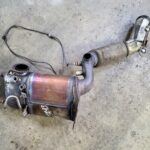The Caterpillar C7 Engine, produced from 2003 to 2009, aimed to revolutionize the medium-duty truck market. Designed to meet stringent EPA emissions standards, this powerplant promised a potent blend of horsepower and clean operation. This article delves into the C7 engine’s history, specs, common problems, and its lasting impact on the trucking industry.
The Rise and Fall of the C7
The C7’s development was driven by the EPA’s Tier 4 emissions regulations, effective in 2004. Replacing the popular CAT 3126, the C7 incorporated innovative technologies like the HEUI (Hydraulically Actuated Electronically Controlled Unit Injector) fuel system for improved combustion and reduced emissions. Major truck manufacturers, including Paccar, Freightliner, Ford, and GMC, readily adopted the C7. However, despite initial enthusiasm, the C7’s journey was marked by challenges.
C7 Engine Design and Technology: A Closer Look
The C7 shared similarities with its predecessor, the 3126, retaining the same bore and stroke dimensions. However, key differences lay in the fuel system, a more advanced ECM (Electronic Control Module), and a redesigned valve train. The C7 boasted a robust 120-pin ECM, capable of processing vast amounts of data for enhanced fuel management and engine control.
The C7 integrated Caterpillar’s ACERT (Advanced Combustion Emissions Reduction Technology), featuring a closed crankcase breather and a diesel particulate filter with regeneration technology. This system precisely controlled the combustion cycle and aftertreatment process to minimize emissions. Various turbocharger configurations, ranging from single to dual variable geometry turbos, optimized airflow based on horsepower requirements. The C7 also offered an integral jake brake on select high-horsepower models.
Common Problems with the C7 Engine
Despite its technological advancements, the C7 faced reliability issues. Its B50 life rating, indicating the mileage at which 50% of engines require an overhaul, fell between 450,000-500,000 miles. While comparable to some engines, it lagged behind others known for longevity. The ACERT system, particularly the regeneration process, proved problematic. Drivers reported low power, poor fuel economy, and overheating, especially on inclines. Clogged diesel particulate filters and turbocharger inlets were also common complaints.
The C7 and Ultra Low Sulfur Diesel (ULSD)
In 2007, the transition to ULSD fuel necessitated modifications to the C7’s fuel system. A common-rail injection system, operating at pressures up to 27,500 psi, replaced the previous HEUI system. While generally effective, this change introduced another potential point of failure. The lower lubricity of ULSD also prompted upgrades to the turbocharger, incorporating variable nozzle technology for improved performance across the RPM range.
C7 Engine Specifications and Dimensions
The C7 is an inline 6-cylinder diesel engine with a 7.2-liter displacement. Horsepower ratings ranged from 210 to 360 hp, with torque outputs from 520 to 925 lb-ft. The engine weighed approximately 1,425 lbs (dry weight) and featured dimensions of 40.6 inches in height, 41.5 inches in length, and 29.8 inches in width.
Conclusion: The C7’s Legacy
The Caterpillar C7 engine represents a significant chapter in the evolution of diesel engine technology. While its ambition to combine power and clean emissions was met with challenges, the C7 paved the way for future advancements. Its eventual discontinuation in the on-highway market marked a turning point for Caterpillar, shifting its focus towards off-road applications less impacted by stringent emissions regulations.

